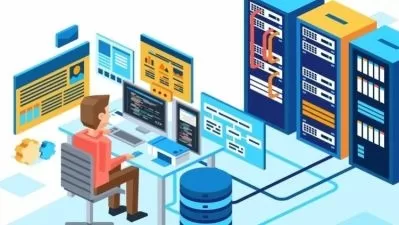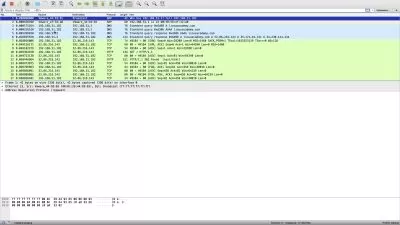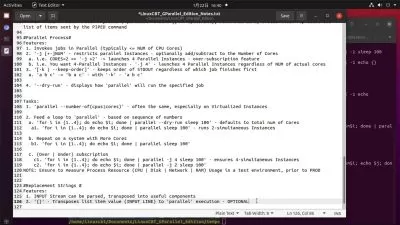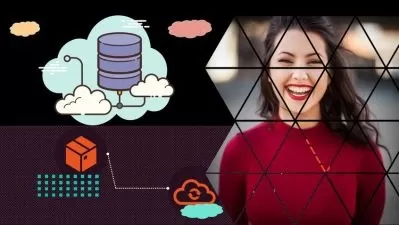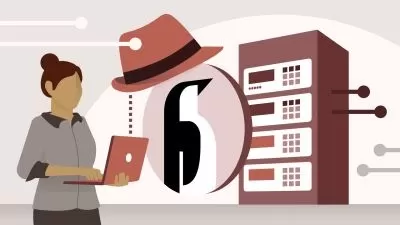Linux Redhat System Administration II – SA2 (RHEL8)
Shikhar Verma • 60k+ Students Worldwide
13:56:47
Description
Key tasks needed to become a full time Linux Administrator and to validate those skills via the Linux Certified System
What You'll Learn?
- Scheduling Future Tasks
- Practice QA for Linux EXAM-200
- Adjusting Tuning Profiles
- Controlling Access to files with ACLs
- Managing SELinux Security
- Adding Partitions, File Systems, and Persistent mounts
- Creating Logical Volumes
- Controlling the Boot Process
- Managing Network Security
- Automating Installation with Kickstart
- Network File System
- KVM Virtualization
- Improving Command-line Productivity
- Introducing containers
- Lab - configure a basic container
Who is this for?
What You Need to Know?
More details
DescriptionLinux Certified System Administrator Exam (E-X: 200 - 2.5 Hours Required), there are two course modules as shown below.
 Linux System Administration I - SA1 (First part)
 Linux System Administration II - SA2 (Second part) ==> This Course Module will teach you this module.
Course Content
Linux System Administration II - SA2 Â with Practice QA for first level of Exam.
Introduction
Overview about the Course Module
Scheduling Future Tasks
Overview of Scheduling Tasks
Scheduling a Deferred User Job
Controlling Nice Values with Queue Designations
Scheduling Recurring User Jobs
Scheduling a job for a specific time - 1
Scheduling a job for a specific time - 2
Practice Lab Session - Scheduling a Recurring User Jobs
Scheduling Recurring System Jobs
Practice Lab Session - System Jobs
Scheduling tasks with Systemd Timer
Practice Lab Session - Systemd Timer
Managing Temporary Files
Cleaning Temporary Files with a Systemd Timer
Lab - Configure systemd-tmpfiles to remove unused temporary files from /tmp
Lab - Configure systemd-tmpfiles to periodically purge files from another directory
Adjusting Tuning Profiles
Overview about tuning profiles
Managing profiles from the command line
Lab Session - Tune a server’s performance by activating the tuned service and apply a tuning profile to powersave.
Process Scheduling & Multitasking
Displaying Nice Levels from the Command Line
Changing the Nice Level of an Existing Process
Lab Session: Influencing Process Scheduling
Controlling Access to files with ACLs
Access Control List Concepts
Set ACLs on files
Default ACLs
Viewing and Interpreting ACL Permissions
Lab - set acl on files
Lab - set acl on directories
Lab - Mask to limit the set of permissions
Lab - default acl
Guided Exercise on ACL
Managing SELinux Security
SELinux Security Concepts
SELinux Context
SELinux Modes
Apache service without SELinux Protection (DAC)
Apache service with SELinux Protection (MAC)
Practical approach to understand SELinux
Lab - Change context temporary
Lab - Change context permanently
Lab - SELinux inheritance and its pitfalls
SELinux Booleans
Lab - SELinux Booleans
Audit logs & Troubleshooting SELinux
Adding Partitions, File Systems, and Persistent mounts
Partitioning a Disk
Benefits of disk partitioning
MBR Partitioning Scheme
Primary & Extended Partitions
GPT Partitioning Scheme
How to identify what partitioning standard is used
Managing Partitions with Parted
Creating a file system
Swap Space Concepts
Create a Swap Partitions
Setting the Swap Space Priority
Creating Logical Volumes
The LVM Logical Volume Manager
Features of LVM
LVM Architecture Overview
Architectural Overview via Diagram
LVM Components - PV, VG, LV
Lab 1 - Creation of PV, VG, LV
Lab 2 - Create File System, Mount Point
Lab 3 - Remove a Logical Volume
Lab 4 - Extending and Reducing a Volume Group
Lab 5 - Extending a LV and xfs & ext4 FS
Lab 6 - Extend a swap space
Advanced Storage Features
About Stratis
Lab - Installing & Configuring Stratis
Lab - Managing Stratis File Systems
Lab - Persistently Mounting Stratis File Systems
Lab - Stratis filesystem snapshot
Guided Exercise - Create a thin-provisioned file system
Guided Exercise - Verify file system grows dynamically
Guided Exercise - Create & access data from Snapshot
VDO - Virtual Data Optimizer
Lab - Installation VDO
Lab - Create & format a VDO Volume
Lab - Testing Deduplication:
Recap - Lab
Lab - Extend & Remove VDO Volume
Controlling the Boot Process
Booting Process of a RHEL 8 System
Selecting a systemd target, rebooting & shutting
Lab Exercise - Determine the default target and change the target into running system.
Lab - Selecting a rescue mode at boot time
Resetting a root password
Repairing Systemd Boot Issues
Booting RHEL 8 into Rescue Mode
Booting RHEL 8 into Emergency Mode
Enabling the Early Debug Shell
Repair a File System Issues at boot
Lab - Repair a File System
Managing Network Security
Firewall Concepts
Features and advantages of firewalld
Pre-defined Zones
Packet flow via firewalld
Add, remove services from firewall server - Lab Session
Add http service to allow access the website - Lab Session
Port Forwarding - allow access a website running on 12345 port
masquerading, network address translation
Lab Session - masquerading, port forwarding
rich rules
Lab Session - rich rules
Automating Installation with Kickstart
Overview Kickstart Server
Architectural Overview
Lab 1 - Configure dhcp server
Lab 2 - Configure tftp, pxe boot server
Lec 3 - Configure httpd, kick start configuration file
Lab 4 - Configure http repository, start services
Lab 5 - Boot the Client from Network
Network File System
Overview of NFS
nfsconf tool
Lab - Accessing Network-Attached Storage
Exercise - NFS Share
Mounting NFS Shares with Automounter
Automounter Benefits
Lab - Automounter using indirect map
Lab Session on Indirect Wildcard Maps
Lab Session on Direct maps
KVM Virtualization
Overview of Linux Virtualization
Hypervisor Concept - type 1 & type 2
Types of Virtualization
KVM, QEMU & Libvirt Architecture
virsh command to manager vm's
Lab Session
Introducing Containers
Introducing Container Technology
Planning for containers
Lab - configure a basic container
Lab - mapping container host ports to the container
Lab - stop, restart & remove container
Improving Command-line Productivity
Writing Simple Bash Scripts
Lab - Writing Simple Bash Scripts
Simple Commands in Linux
Variable, single and double quote, backslash
Redirection output
Redirection output - Lab
Last lecture
Who this course is for:
- There is no formal prerequisites for this course; however, previous system administrator experience on other operating system would be very beneficial.
Linux Certified System Administrator Exam (E-X: 200 - 2.5 Hours Required), there are two course modules as shown below.
 Linux System Administration I - SA1 (First part)
 Linux System Administration II - SA2 (Second part) ==> This Course Module will teach you this module.
Course Content
Linux System Administration II - SA2 Â with Practice QA for first level of Exam.
Introduction
Overview about the Course Module
Scheduling Future Tasks
Overview of Scheduling Tasks
Scheduling a Deferred User Job
Controlling Nice Values with Queue Designations
Scheduling Recurring User Jobs
Scheduling a job for a specific time - 1
Scheduling a job for a specific time - 2
Practice Lab Session - Scheduling a Recurring User Jobs
Scheduling Recurring System Jobs
Practice Lab Session - System Jobs
Scheduling tasks with Systemd Timer
Practice Lab Session - Systemd Timer
Managing Temporary Files
Cleaning Temporary Files with a Systemd Timer
Lab - Configure systemd-tmpfiles to remove unused temporary files from /tmp
Lab - Configure systemd-tmpfiles to periodically purge files from another directory
Adjusting Tuning Profiles
Overview about tuning profiles
Managing profiles from the command line
Lab Session - Tune a server’s performance by activating the tuned service and apply a tuning profile to powersave.
Process Scheduling & Multitasking
Displaying Nice Levels from the Command Line
Changing the Nice Level of an Existing Process
Lab Session: Influencing Process Scheduling
Controlling Access to files with ACLs
Access Control List Concepts
Set ACLs on files
Default ACLs
Viewing and Interpreting ACL Permissions
Lab - set acl on files
Lab - set acl on directories
Lab - Mask to limit the set of permissions
Lab - default acl
Guided Exercise on ACL
Managing SELinux Security
SELinux Security Concepts
SELinux Context
SELinux Modes
Apache service without SELinux Protection (DAC)
Apache service with SELinux Protection (MAC)
Practical approach to understand SELinux
Lab - Change context temporary
Lab - Change context permanently
Lab - SELinux inheritance and its pitfalls
SELinux Booleans
Lab - SELinux Booleans
Audit logs & Troubleshooting SELinux
Adding Partitions, File Systems, and Persistent mounts
Partitioning a Disk
Benefits of disk partitioning
MBR Partitioning Scheme
Primary & Extended Partitions
GPT Partitioning Scheme
How to identify what partitioning standard is used
Managing Partitions with Parted
Creating a file system
Swap Space Concepts
Create a Swap Partitions
Setting the Swap Space Priority
Creating Logical Volumes
The LVM Logical Volume Manager
Features of LVM
LVM Architecture Overview
Architectural Overview via Diagram
LVM Components - PV, VG, LV
Lab 1 - Creation of PV, VG, LV
Lab 2 - Create File System, Mount Point
Lab 3 - Remove a Logical Volume
Lab 4 - Extending and Reducing a Volume Group
Lab 5 - Extending a LV and xfs & ext4 FS
Lab 6 - Extend a swap space
Advanced Storage Features
About Stratis
Lab - Installing & Configuring Stratis
Lab - Managing Stratis File Systems
Lab - Persistently Mounting Stratis File Systems
Lab - Stratis filesystem snapshot
Guided Exercise - Create a thin-provisioned file system
Guided Exercise - Verify file system grows dynamically
Guided Exercise - Create & access data from Snapshot
VDO - Virtual Data Optimizer
Lab - Installation VDO
Lab - Create & format a VDO Volume
Lab - Testing Deduplication:
Recap - Lab
Lab - Extend & Remove VDO Volume
Controlling the Boot Process
Booting Process of a RHEL 8 System
Selecting a systemd target, rebooting & shutting
Lab Exercise - Determine the default target and change the target into running system.
Lab - Selecting a rescue mode at boot time
Resetting a root password
Repairing Systemd Boot Issues
Booting RHEL 8 into Rescue Mode
Booting RHEL 8 into Emergency Mode
Enabling the Early Debug Shell
Repair a File System Issues at boot
Lab - Repair a File System
Managing Network Security
Firewall Concepts
Features and advantages of firewalld
Pre-defined Zones
Packet flow via firewalld
Add, remove services from firewall server - Lab Session
Add http service to allow access the website - Lab Session
Port Forwarding - allow access a website running on 12345 port
masquerading, network address translation
Lab Session - masquerading, port forwarding
rich rules
Lab Session - rich rules
Automating Installation with Kickstart
Overview Kickstart Server
Architectural Overview
Lab 1 - Configure dhcp server
Lab 2 - Configure tftp, pxe boot server
Lec 3 - Configure httpd, kick start configuration file
Lab 4 - Configure http repository, start services
Lab 5 - Boot the Client from Network
Network File System
Overview of NFS
nfsconf tool
Lab - Accessing Network-Attached Storage
Exercise - NFS Share
Mounting NFS Shares with Automounter
Automounter Benefits
Lab - Automounter using indirect map
Lab Session on Indirect Wildcard Maps
Lab Session on Direct maps
KVM Virtualization
Overview of Linux Virtualization
Hypervisor Concept - type 1 & type 2
Types of Virtualization
KVM, QEMU & Libvirt Architecture
virsh command to manager vm's
Lab Session
Introducing Containers
Introducing Container Technology
Planning for containers
Lab - configure a basic container
Lab - mapping container host ports to the container
Lab - stop, restart & remove container
Improving Command-line Productivity
Writing Simple Bash Scripts
Lab - Writing Simple Bash Scripts
Simple Commands in Linux
Variable, single and double quote, backslash
Redirection output
Redirection output - Lab
Last lecture
Who this course is for:
- There is no formal prerequisites for this course; however, previous system administrator experience on other operating system would be very beneficial.
User Reviews
Rating
Shikhar Verma • 60k+ Students Worldwide
Instructor's Courses
Udemy
View courses Udemy- language english
- Training sessions 131
- duration 13:56:47
- Release Date 2022/12/03






